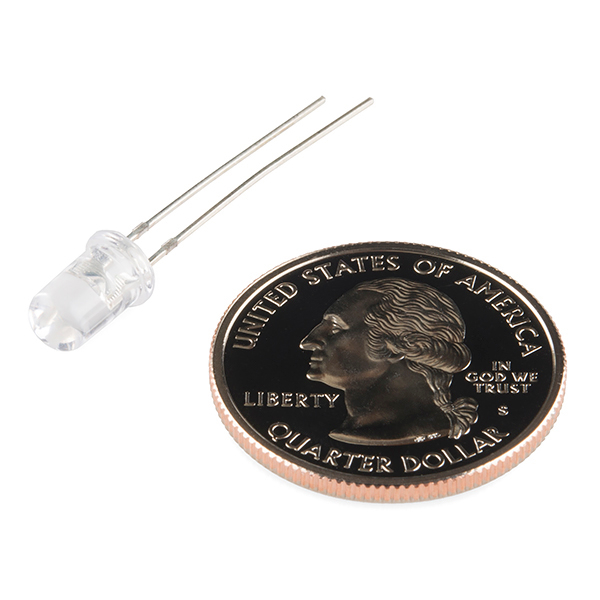LED - Violet 5mm
LEDs - those blinky things. A must have for power indication, pin status, opto-electronic sensors, and fun blinky displays.
This is a very basic 5mm violet LED. It has a typical forward voltage of 3.0-3.6V and a rated forward current of 30mA.
- Forward Voltage:
- Min: 3.0V
- Max: 3.6V
- Max current: 30mA
- 400nm Wavelength
LED - Violet 5mm Product Help and Resources
Core Skill: Electrical Prototyping
If it requires power, you need to know how much, what all the pins do, and how to hook it up. You may need to reference datasheets, schematics, and know the ins and outs of electronics.
Skill Level: Rookie - You may be required to know a bit more about the component, such as orientation, or how to hook it up, in addition to power requirements. You will need to understand polarized components.
See all skill levels
Comments
Looking for answers to technical questions?
We welcome your comments and suggestions below. However, if you are looking for solutions to technical questions please see our Technical Assistance page.
Customer Reviews
5 out of 5
Based on 1 ratings:
1 of 1 found this helpful:
Lovely and bright
Purple is my favorite color, and I hadn't seen any purple LEDs before this, so I was excited to discover these violet ones. They seem really bright for LEDs, which has been pretty useful.




These are definitely violet, with a good dose of UV thrown in, and not the "purple" you get from a red-blue combination such as with RGB LEDs. I tested a few of these on a breadboard with 5v and a potentiometer, with a few other lights for comparison. At very low intensities these LEDs appear violet to the eye. As the intensity increases with higher current, the color turns pale blue, and does a pretty good job of lighting up various colors of fluorescent paper, which is the UV portion doing its job. See Wikipedia's color swatches for blue, violet and purple for comparison.
SparkFun should make an effort to get the data sheets and specs for LED's and other photonic devices. UV radiation can be harmful if not careful... UV radiation can be useful at certain wavelengths....
Just received some. They are... violet! Close to UV - not purple at all. Indeed, they perform identically to the Ultra-voilet LED's. Like those, these can (faintly) reveal the security marks on currency. Given their similarities to the aforementioned, I'm guessing they're 400nm - just brushing the edge of UVA.
I've been looking for some of the blue + red ones, like the kind you find in christmas light sets. I guess I'll keep looking :)
Is there a datasheet available for this LED? I am interested in it's wavelength and output mcd's.
According to this photon energy-wavelength calculator (http://www.pveducation.org/pvcdrom/properties-of-sunlight/energy-of-photon) if the photon energy is ~3.4 eV (for forward V drop of 3.4 V) then the wavelength would be 365 nm. This is an approximation since I don't know if the forward voltage drop will give the actual eV of the photon. Does anyone on this know for sure? This is a good UV wavelength, about the same as one of the Hg lines (365 nm) used in early photolitho.
There are also 5mm UV LEDs on here
I wouldn't read too much into these listed forward voltages - the Basic Blue and Super Bright Blue are also listed 3.4V.
The picture sure does look blue to me
I was thinking the same thing. I have my monitors calibrated too. It could be the camera which could not be showing how this really looks.
Is it purple or violet?
I must be asking a question too hard for the engineers. Hint: Purple consists of Blue and Red, and usually violet light. Violet only has the top end of the spectrum.
We often do not catch all of the new comments that come in, and are not attempting to avoid answering you or simply don't understand. The issue is that for things like this that we do not make in-house, we have to wait until we can get a data sheet from the manufacturer (as several other customers have requested as well), and unfortunately, there is not always a quick turn around time on that.
Is this a "conventional" LED, or one of those multi-frequency ones (blue with a red phosphor)? If it's conventional, what wavelength is it?
A datasheet would be preferable.